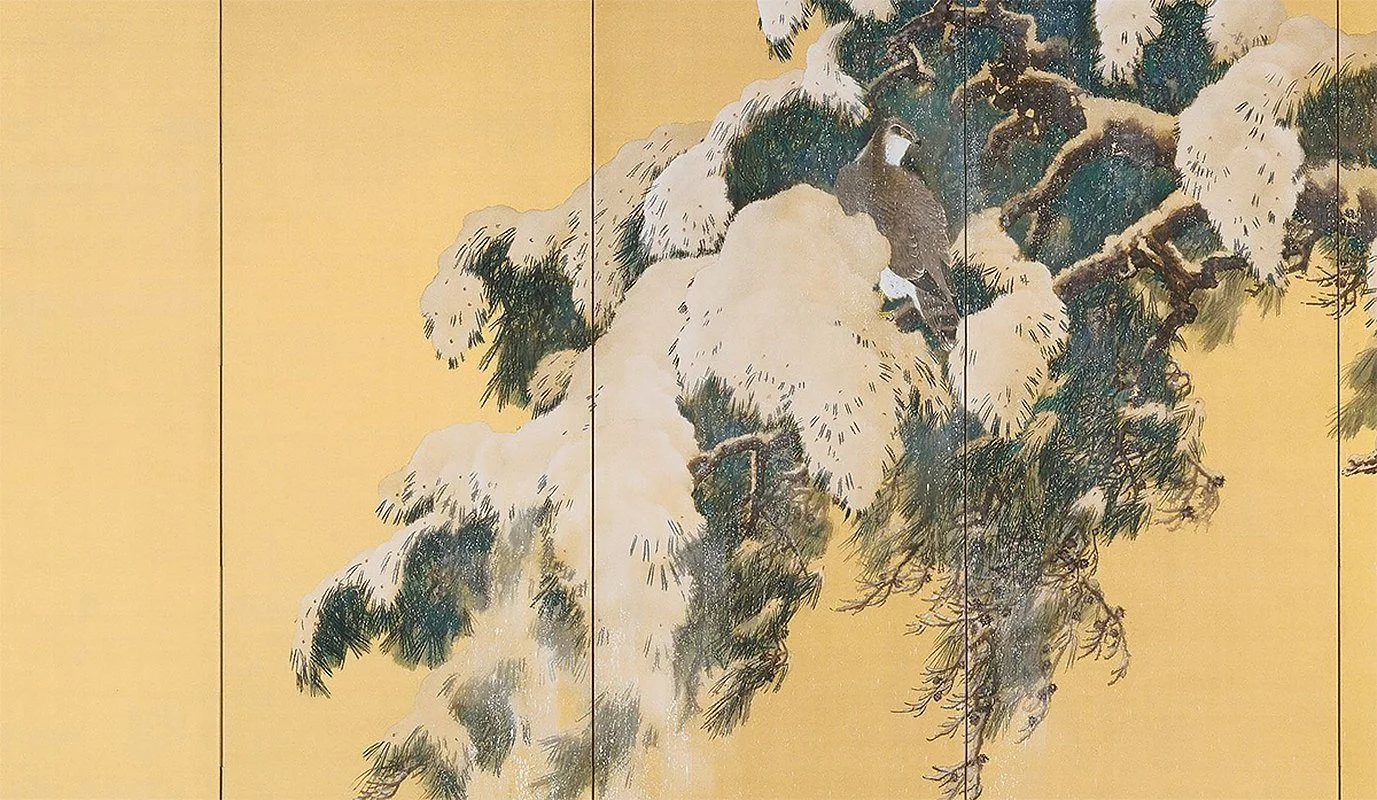PAINTINGS & SCREENS
YAMAMOTO SHUNKYO, 1924, PAIR OF BYOBU WITH HAWK & SNOW ON PINES
Pair of byobu or folding screens in six panels, painted on silk in mineral pigments, gofun or clam shell gesso, and sumi ink, with a scene of snow laden pine trees in bright sun, the left hand pine sheltering a large hawk and the right two sparrows. Signed on the lower right side of the right hand screen and on the lower left side of the left hand screen by the artist: Shunkyo, and sealed twice: Ittetsu Koji and: Ashi Hana Asamizu So (Yamamoto Shunkyo, 1871 – 1933). Completed in January of Taisho 13 or 1924.
With a lacquered cypress wood screen storage box, titled on the exterior of the lid by the artist: Rei O Sessho Zu or Spirit of the Hawk, Snow and Pine Painting, and signed: Shunkyo Jidai or Titled by Shunkyo, and sealed: Shunkyo. A small tomobako or original box contains the receipts, inscribed on the exterior of the lid: Shunkyo Settsu Chü Oimatsu Taka Byobu Kigo or Shunkyo Original Screen Painting (Depicting) a Snow Scene (With) Old Pines and Hawk. Enclosed are Shunkyo’s original receipt for 5,000 yen for the commissioned painting dated to January 26, 1924. This commission represented an extraordinary amount of money at the time, enough to purchase five large houses in the heart of Kyoto. The price stands as a testament to Shunkyo’s reputation and standing in the Japanese art world.
Yamamoto Shunkyo valued landscape painting above figure painting, and was one of the foremost realists of his generation. Influenced by photography (an avocation at which he taught himself to excel) and Western painting, Shunkyo studied painting under Nomura Bunkyo and Mori Kansai. In 1899 he started teaching at the Kyoto Municipal School of Arts and Crafts, later becoming a professor at the Kyoto Municipal Special School of Painting. He was an exhibitor at the Bunten, and showed his work at many of the Teiten. In 1917 he was honored as a Teishitsu Gigeiin or Imperial Household Artist.
Shunkyo loved winter landscapes and in this masterful painting renders the effect of bright sun on snow. The choice to soften the gold ground through the use of urahaku or gold foil backing the silk creates a glowing background to the painting. Dryer brush strokes detail the hard pine needles in the foreground; the brown of the trunk, branches and cones painted in wet, suggestive tarashikomi. Pine needles washed in green and blue (pigments ground from malachite and azurite) intensify beneath the cool white. The snow cascades off the branches in spatters, washes and the thinnest lines of white gofun. In places the mounded snow seems to recede, in a thin milkiness that contrasts with the deeper white of the foreground. This perspective gives depth to the painting, heightened by Shunkyo’s treatment of the pine fading in the extreme right of the right hand screen. Partly this creates distance, and partly the shimmering sense of light reflecting off of snow. This also plays to the diagonal composition framed by the form of the pines, and the commanding line of sight darting downward and to the right from the hawk’s eye to his prey. Throughout, Shunkyo allows the gold shimmering through from behind the silk to emphasize the glitter of the snow, or by thinning the application of color as along the hawk’s nape and shoulder to add brilliance.
These paintings express a sense of evanescent intensity, of the still quiet of a snow blanketed scene broken by the hawk’s sudden awareness, and the quiver of snow showering off of the pine. Shunkyo folds the hawk in a deep hollow of pine, exposing the sparrows at the end of a curling branch. The inherent drama enlivens this return of Shunkyo to a theme he treated sixteen years earlier. In Meiji 41 or 1908 he painted a series of four six-panel screens with pine and snow against a gold ground for exhibition at the second Bunten. Illustrated in color in the Nittenshi, volume 1, number 86, pages 180 – 181, these paintings are now in the collection of the Tokyo National Museum of Modern Art. The earlier version seems to be painted only in sumi or ink against a gold ground, and lack the richness of color and dramatic unity of composition of these paintings. In addition to the hawk and sparrows, these 1924 screens display a brilliant rendering of falling snow lacking in the earlier treatment. We know of one other pair of screens by Shunkyo on this theme, in a private collection in Western Japan, rendered again only in sumi but inclusive of the hawk and sparrow motif. Yamamoto Shunkyo’s fascination with snow appears to have deepened across his career, a study that triumphed in these paintings. At once realistic and impressionist, they perfectly convey the play of light and crystalline beauty of a winter morning.
These paintings are illustrated in Kagedo’s catalogue Light Through Clouds, number 23. Now in the collection of the Museum of Fine Arts, Boston.
Yamamoto Shunkyo, 1924, Pair of Byobu with Hawk & Snow on Pines
Artist Name: Yamamoto Shunkyo
Period: Meiji Taisho
Mediums: Mineral Pigments
Form: Screen
Origin Country: Japan
67 ¾” high x 147 ¼” across, dimensions of each screen when opened flat
This piece is no longer available.







